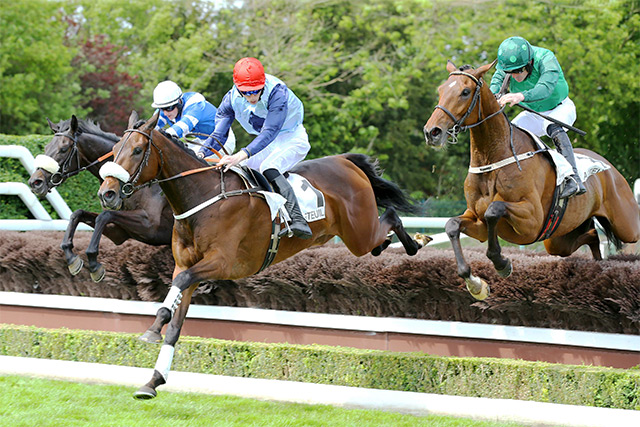The basics
Racing is categorised based on a horse’s age, sex, and their ability. Like male and female athletes, they run over specific distances, generally from 1,000 to 3,200 metres, and like runners, they are sprinters, middle-distance, or long distance performers.
Jump racing is split into three types, hurdles (small identical jumps), steeplechase (bigger jumps and varied), and cross-country (often an undulating track with varied and some naturally occurring jumps). It functions the same way as flat racing, but the races are run over a minimum distance of 3,000 metres.

A hurdle race at Auteuil.
The majority of horses that take part in racing are thoroughbreds, a breed that has been specifically developed from Purebred Arabians and European horses for this vocation since the 17th Century. They are the Formula 1 cars of horses. Certain breeds have been developed from thoroughbred origins, including Anglo Arabs, half-breds, AQPS etc.
Thoroughbreds are bred worldwide in studs by breeders. Often, these are sold as youngsters to owners, for whom they will carry their colours (silks) in races. Their breeders can also keep them to race, making them “owner-breeders”.
In general, owners send their horses to trainers, who, for an agreed fee, train, feed, and look after these thoroughbreds and prepare them for racing both at their stables and on the training tracks. Certain trainers are also owners, and vice versa.

Horses in training on Les Aigles gallop in Chantilly.
These horses are then entered into races organised by France Galop (or other institutions depending on the country) by the trainers, when jockeys will then ride them. The most talented trainers and jockeys are always the most in demand, like in football. They also receive a percentage of a horse’s winnings. The race winnings, or prize money, are rewarded to the owners of the horses with the best placings in a race. This is financed by betting, of which the governing bodies of racing receive a share to be able to allocate to these competitions.
Right from its origin, racing has been intrinsically linked with betting. It started with match races resulting from owners saying, “My horse is better than yours!”, which incidentally, is still the purpose of racing today. This first races involved breeders and owners, spread to their friends, and then the public, which very quickly adopted the betting culture.
Betting has since diversified. Initially, people were only able to bet on a horse to win, then to be placed (finishing in the first two or three places subject to the total number of runners), and then on the first two past the post (couple, jumele).
This then diversified to being able to bet on the first three past the post in order (tierce), which made racing very popular in the 50s. Today, the Quinte+ is the Frenchman’s favourite bet: guess the first five past the post in a particular race. This is available every day.